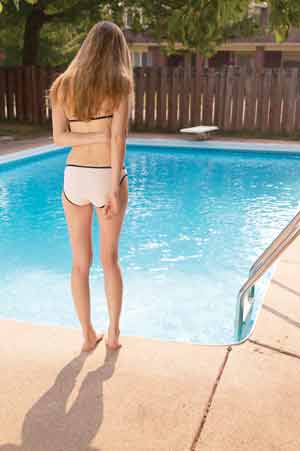Splashing Safe
Keep watch at residential pools

They’re just numbers, but statistics can be scary.
Consider this: Eight-eight percent of children who drown are under the supervision of another person, according to a study by the National Safe Kids campaign.
And that person usually is a family member, although not necessarily in direct sight of the child. If you’re a pool owner or a parent or guardian, how would you feel if your name were attached to those statistics?
Lack of supervision accounts for about 75 percent of drownings, according to the Florida Swimming Pool Association. Protective barriers, lifesaving equipment, alarms, locks and a healthy dose of water-safety know-how greatly reduce accidents and drownings in the home pool.
In fact, proper installation and use of fencing could prevent 50 percent to 90 percent of residential pool drownings, Safe Kids reports.
Given the Triangle’s warm weather, pools are common in our area. Here’s what you need to know to create a water-safety plan.
Supervision
Safe Kids recommends that adults take turns serving as “water watchers,” lifeguards who constantly observe children in or near the water. If the children are young and non-swimmers, an arm’s-length away is a safe distance. If this sounds unrealistic, remind yourself that drowning is the second-leading cause of injury-related deaths among children ages 1 to 15 in the nation, according to the Centers for Disease Control and Prevention.
Environment
According to the Safe Kids study, 98 percent of pool- or spa-owning parents reported they have taken adequate steps to ensure children’s safety, but most of them have not taken all the necessary precautions. Part of the reason is cost to the homeowner, but sometimes it’s forgetfulness or neglect. Pool-safety standards are difficult to enforce because they change through the years.
Most requirements include a pool barrier or an approved safety cover to enclose residential swimming pools and spas. And if any of the home’s barrier walls have openings, such as windows or doors, an alarm or a lock system should be in place.
Also, when a contract is signed for a swimming pool or spa, a contractor, home builder or developer should provide a copy of the law and drowning-prevention literature.
Gear and Equipment
The American Red Cross recommends keeping basic lifesaving equipment poolside.
The gear includes:
• Plastic ring bouys with a rope attached or a shepherd’s hook.
• First-aid kits that include sunscreen and a list of emergency-telephone numbers.
• A phone, preferably cordless, that can be used to call 911.
• Bouy line secured across the shallow end of the pool, at least 1 foot before the deep-end drop-off.
Education
Parents and children should learn about aquatic safety.
The National Safe Kids campaign recommends that youngsters be enrolled in swimming lessons with a certified instructor by age 8.
Safe Start at the YMCA, for instance, is a drowning-
prevention program geared for those ages 1 through 4. Children are taught survival-swim techniques.


